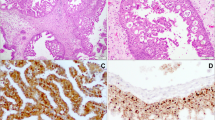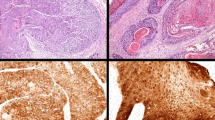Abstract
This study investigated the role of human papillomavirus (HPV) in Schneiderian papillomas (SPs) to determine whether HPV is associated with the pathogenesis of particular histologic subtypes and whether p16INK4a can be used as a surrogate marker for HPV detection. Twenty-seven papilloma specimens (19 inverted [IPs], 6 exophytic [EPs], 1 oncocytic [OP] and 1 mixed) were collected from 23 patients. Purified SP DNA extracts were tested for HPV by PCR using GP5 +/GP6 + primers; HPV genotyping was performed by dot blot hybridization. PCR positive specimens were screened for HPV by biotinyl-tyramide-based chromogenic in situ hybridization (CISH). Immunohistochemsistry (IHC) for the HPV L1 capsid protein and for p16INK4a was performed on all specimens. HPV was detected by PCR in 16/27 (59.3%) SPs; 9/19 (47.4%) IPs; 6/6 (100%) EPs [p = 0.051], and 1/1 (100%) mixed SP. HPV was not detected in the single OP. High risk genotypes were detected in 4/9 IPs (44.4%) and 0/6 EPs (0%) [p = 0.10]. Seven of 16 PCR positive SPs were also CISH positive for HPV: 5/6 EPs (83.3%) and 1/9 IP (11.1%) [p = 0.01]. IHC for the L1 capsid protein was positive in 2 SPs (1 EP and 1 mixed). p16INK4a staining was seen in 14/16 (87.5%) PCR positive SPs and in 10/11 (90.9%) PCR negative SPs (p = 1.00). In summary, this study demonstrates a strong association between HPV and EPs, however, its role in IPs remains less well-defined. Further, p16INK4a is not a useful surrogate marker for HPV detection across the various SPs.







Similar content being viewed by others
References
Perez-Ordonez B. Special tumours of the head and neck. Curr Diagn Pathol. 2003;9:366–83.
Barnes L, Eveson JW, Reichart P, Sidransky D, editors. Pathology and genetics of head and neck tumours. World health organization classification of tumours. Lyon, France: IARC Press; 2005.
Hyams VJ. Papillomas of the nasal cavity and paranasal sinuses. A clinicopathological study of 315 cases. Ann Otol Rhinol Laryngol. 1971;80:192–206.
Syrjanen S, Happonen RP, Virolainen E, et al. Detection of human papillomavirus (HPV) structural antigens and DNA types in inverted papillomas and squamous cell carcinomas of the nasal cavities and paranasal sinuses. Acta Otolaryngol. 1987;104:334–41.
Syrjanen KJ. HPV infections in benign and malignant sinonasal lesions. J Clin Pathol. 2003;56:174–81.
Gaffey MJ, Frierson HF, Weiss LM, et al. Human papillomavirus and Epstein-Barr virus in sinonasal Schneiderian papillomas. An in situ hybridization and polymerase chain reaction study. Am J Clin Pathol. 1996;106:475–82.
Judd R, Zaki SR, Coffield LM, et al. Sinonasal papillomas and HPV: HPV 11 detected in fungiform Schneiderian papillomas by in situ hybridization and PCR. Hum Pathol. 1991;22:550–6.
Weiner JS, Sherris D, Kasperbauer J, et al. Relationship of HPV to Schneiderian papillomas. Laryngoscope. 1999;109:21–6.
Buchwald C, Franzmann MB, Jacobsen GK, et al. Human papillomavirus (HPV) in sinonasal papillomas: a study of 78 cases using in situ hybridization and polymerase chain reaction. Laryngoscope. 1995;105:66–71.
Lawson W, Schlecht NF, Brandwein-Gensler M. The role of the human papillomavirus in the pathogenesis of Schneiderian inverted papillomas: an analytic overview of the evidence. Head Neck Pathol. 2008;2:49–59.
Lawson W, Ho BT, Shaari CM, et al. Inverted papilloma: a report of 112 cases. Laryngoscope. 1995;105:282–8.
Beck JC, McClatchey KD, Lesperance MM, et al. Presence of human papillomavirus predicts recurrence of inverted papilloma. Otolaryngol Head Neck Surg. 1995;113:49–55.
Ward BE, Fechner RE, Mills SE. Carcinoma arising in oncocytic Schneiderian papilloma. Am J Surg Pathol. 1990;14:364–9.
Kaufman MR, Brandwein MS, Lawson W. Sinonasal papillomas: clinicopathologic review of 40 patients with inverted and oncocytic schneiderian papillomas. Laryngoscope. 2002;112:1372–7.
Christensen WN, Smith RR. Schneiderian papillomas: a clinicopathologic study of 67 cases. Hum Pathol. 1986;17:393–400.
Buchwald C, Franzmann MB, Jacobsen GK, et al. Carcinomas occurring in papillomas of the nasal septum associated with human papilloma virus (HPV). Rhinology. 1997;35:74–8.
Norris HJ. Papillary lesions of the nasal cavity and paranasal sinuses. Part I. Exophytic (squamous) papillomas. A study of 28 cases. Laryngoscope. 1962;72:1784–97.
Zur Hausen H. Papillomaviruses and cancer: from basic studies to clinical application. Nat Rev Cancer. 2002;2:342–50.
Klussmann JP, Gultekin E, Weissenborn SJ, et al. Expression of p16 protein identifies a distinct entity of tonsillar carcinomas associated with human papillomavirus. Am J Pathol. 2003;162:747–53.
Kalof AN, Cooper K. p16INK4a immunoexpression: surrogate marker of high-risk HPV and high-grade cervical intraepithelial neoplasia. Adv Anat Pathol. 2006;13:190–4.
Allende DS, Hoschar A, Batra P, et al. Dysplasia and carcinomas arising in Schneiderian papillomas, 20 years experience. Mod Pathol. 2008;21:231A.
Allende DS, Hoschar A, Hunt JL. Exophytic Schneiderian papillomas and their differential diagnosis: Can p16 help in the diagnosis of these two entities? Mod Pathol. 2008;21:231A.
Evans MF, Adamson CS, Simmons-Arnold L, et al. Touchdown general primer (GP5 +/GP6 +) PCR and optimized sample DNA concentration support the sensitive detection of human papillomavirus. BMC Clin Pathol. 2005;5:10–1.
Evans MF, Mount SL, Beatty BG, et al. Biotinyl-tyramide-based in situ hybridization signal patterns distinguish human papillomavirus type and grade of cervical intraepithelial neoplasia. Mod Pathol. 2002;15:1339–47.
Evans MF, Aliesky HA, Cooper K. Optimization of biotinyl-tyramide-based in situ hybridization for sensitive background-free applications on formalin-fixed, paraffin-embedded tissue specimens. BMC Clin Pathol. 2003;3(1):2.
Evans MF, Cooper K. Human papillomavirus integration: detection by in situ hybridization and potential clinical application. J Pathol. 2004;202:1–4.
Yang B, Hart WR. Vulvar intraepithelial neoplasia of the simplex (differentiated) type: a clinicopathologic study including analysis of HPV and p53 expression. Am J Surg Pathol. 2000;24:429–41.
Skinner GR. Transformation of primary hamster embryo fibroblasts by type 2 simplex virus: evidence for a “hit and run” mechanism. Br J Exp Pathol. 1976;57:361–76.
Barnes L. Schneiderian papillomas and nonsalivary glandular neoplasms of the head and neck. Mod Pathol. 2002;15:279–97.
Kuo KT, Hsiao CH, Lin CH, Kuo LT, Huang SH, Lin MC. The biomarkers of human papillomavirus infection in tonsillar squamous cell carcinoma-molecular basis and predicting favorable outcome. Mod Pathol. 2008;21:376–86.
Matsukura T, Sugase M. Pitfalls in the epidemiologic classification of human papillomavirus types associated with cervical cancer using polymerase chain reaction: driver and passenger. Int J Gynecol Cancer. 2008;18:1042–50.
Author information
Authors and Affiliations
Corresponding author
Rights and permissions
About this article
Cite this article
Shah, A.A., Evans, M.F., Adamson, C.SC. et al. HPV DNA is Associated with a Subset of Schneiderian Papillomas but Does not Correlate with p16INK4a Immunoreactivity. Head and Neck Pathol 4, 106–112 (2010). https://doi.org/10.1007/s12105-010-0176-4
Received:
Accepted:
Published:
Issue Date:
DOI: https://doi.org/10.1007/s12105-010-0176-4




